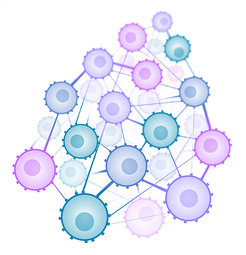Researchers unravel the social network of immune cells

Facebook, Instagram, Twitter – nowadays, good social networking and communication is more important than ever. The immune system also resembles a large social network, as shown by Felix Meissner and his team in the Experimental System Immunology Research Group at the Max Planck Institute of Biochemistry in Martinsried. With the help of proteomics they deciphered the messages exchanged between immune cells responsible for protecting us against diseases. In doing so, they have discovered complex cellular communication structures and previously unknown connections between various cell types. Their research findings were published in the journal Nature Immunology.
Social networks such as Facebook now connect people around the globe, for the exchange of countless messages and pieces of information every day. Some people prefer to use social networks passively, only reading messages, while others have a strong need to communicate with others and tend to send out a large volume of information. The cells of our immune system work in a similar manner. When cells wish to communicate with each other, they emit messengers, unique signal molecules, which are detected by other cells via cell surface receptors. These messengers disseminate information throughout the body to control immune reactions against pathogens. Some cell types are more communicative than others. “Innate immune cells such as macrophages are real chatterboxes,” Meissner says.
